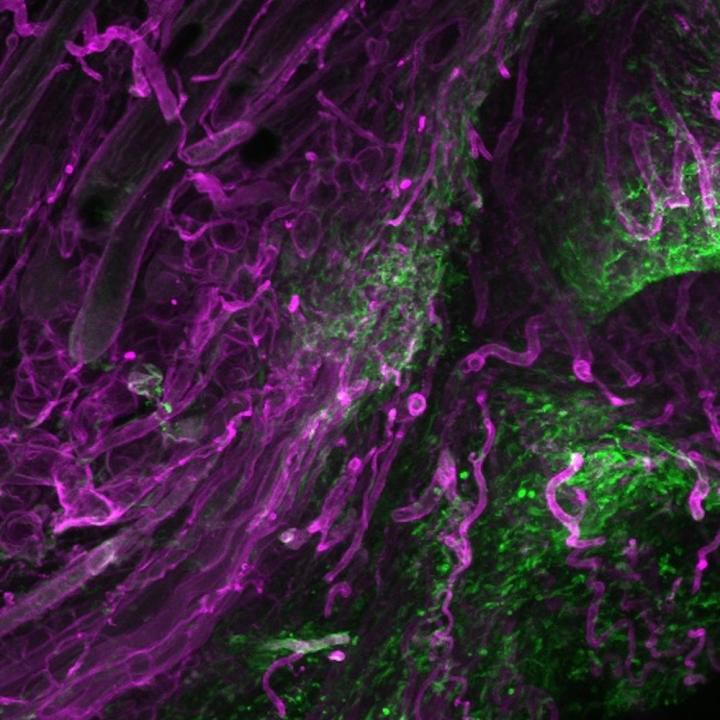How do scars form? Fascia function as a repository of mobile scar tissue

Fascia cells (green) rising into dermal open wounds dragging their surrounding matrix (magenta). Credit: © Helmholtz Zentrum München / Donovan Correa -Gallegos
Fibroblasts kit – ready to heal wounds
In order to find out, they used an array of techniques including genetic lineage tracing, anatomical fate mapping, and genetic ablation, a method which in selected cells leads to apoptosis, cell death. This extinguished the fascia fibroblasts. It was discovered that no matrix was incorporated into the wounds and only abnormal and unhealthy scars with major disadvantages were formed.
In another approach the team placed a porous film beneath the skin to prevent fascia fibroblasts from migrating upwards. This, however, led to chronic open wounds. The researchers concluded that fascia contains a specialized prefabricated kit of sentry fibroblasts, embedded within a movable sealant, that preassemble together all the cell types and matrix components needed to heal wounds. They are assuming that guided homing of fascia initiates the hallmark response to external and internal injuries.
Scarring ensures survival
The new findings are important in context of ensuring survival: In mammals scarring injury induces a universal fibrotic tissue response that quickly patches wounds with scars – and thus prevents infection and bleeding to death. The hitherto tenet in wound repair was that scars form de novo by fibroblasts depositing extracellular matrix at sites of injury. With this study, the researchers could proof that scars originate from reservoirs of matrix jelly that are dragged into open wounds by sentry fibroblasts embedded in the fascia. These novel findings contradict current paradigms of how wounds repair.
New methods of scarless regenerative healing
The knowledge that fascia is the origin of scars and the finding of new mechanisms of wound repair provide a novel therapeutic space to curtail pathological fibrotic responses and induce scarless regenerative healing across a range of medical settings.
“The findings of our research give fascia tissue a new role for future science. This will shift the attention of the scientific community to not only to look at fibroblasts in the dermis but also at native cells in the fascia when researching on wound healing,” says Rinkevich.
Donovan Correa-Gallegos, PhD student at Helmholtz Zentrum München and first co-author of the study, comments: “Our new findings challenge and reconfigure the traditional view of the body's matrix system of connective tissue. This is opening up a new biological concept that radiates to a variety of aspects of scar-related disease.”
###
Further information
The project was funded by the Human Frontier Science Program Career Development Award, the German Research Foundation, Fritz-Thyssen-Stiftung (2016-01277) and a European Research Council Consolidator Grant. The first co-author Donovan Correa-Gallegos was supported by the Consejo Nacional de Ciencia y Tecnología (CONACYT) and Deutscher Akademischer Austauschdienst (DAAD).
Original publication
Correa-Gallegos, D. et al., 2019: Fascia is a repository of mobile scar tissue. Nature, DOI: 10.1038/s41586-019-1794-y
The Helmholtz Zentrum München, the German Research Center for Environmental Health, pursues the goal of developing personalized medical approaches for the prevention and therapy of major common diseases such as diabetes, allergies and lung diseases. To achieve this, it investigates the interaction of genetics, environmental factors and lifestyle. The Helmholtz Zentrum München is headquartered in Neuherberg in the north of Munich and has about 2,500 staff members. It is a member of the Helmholtz Association, a community of 19 scientific-technical and medical-biological research centers with a total of about 37,000 staff members. http://www.
The Comprehensive Pneumology Center (CPC) is a joint research project of the Helmholtz Zentrum München, the Ludwig-Maximilians-Universität Clinic Complex and the Asklepios Fachkliniken München-Gauting. The CPC's objective is to conduct research on chronic lung diseases in order to develop new diagnosis and therapy strategies. The CPC maintains a focus on experimental pneumology with the investigation of cellular, molecular and immunological mechanisms involved in lung diseases. The CPC is a site of the Deutsches Zentrum für Lungenforschung (DZL). http://www.
Media Contact
All latest news from the category: Health and Medicine
This subject area encompasses research and studies in the field of human medicine.
Among the wide-ranging list of topics covered here are anesthesiology, anatomy, surgery, human genetics, hygiene and environmental medicine, internal medicine, neurology, pharmacology, physiology, urology and dental medicine.
Newest articles

Going Steady—Study Reveals North Atlantic’s Gulf Stream Remains Robust
A study by the University of Bern and the Woods Hole Oceanographic Institution in the USA concludes that the ocean circulation in the North Atlantic, which includes the Gulf Stream,…

Single-Celled Heroes: Foraminifera’s Power to Combat Ocean Phosphate Pollution
So-called foraminifera are found in all the world’s oceans. Now an international study led by the University of Hamburg has shown that the microorganisms, most of which bear shells, absorb…

Humans vs Machines—Who’s Better at Recognizing Speech?
Are humans or machines better at recognizing speech? A new study shows that in noisy conditions, current automatic speech recognition (ASR) systems achieve remarkable accuracy and sometimes even surpass human…



